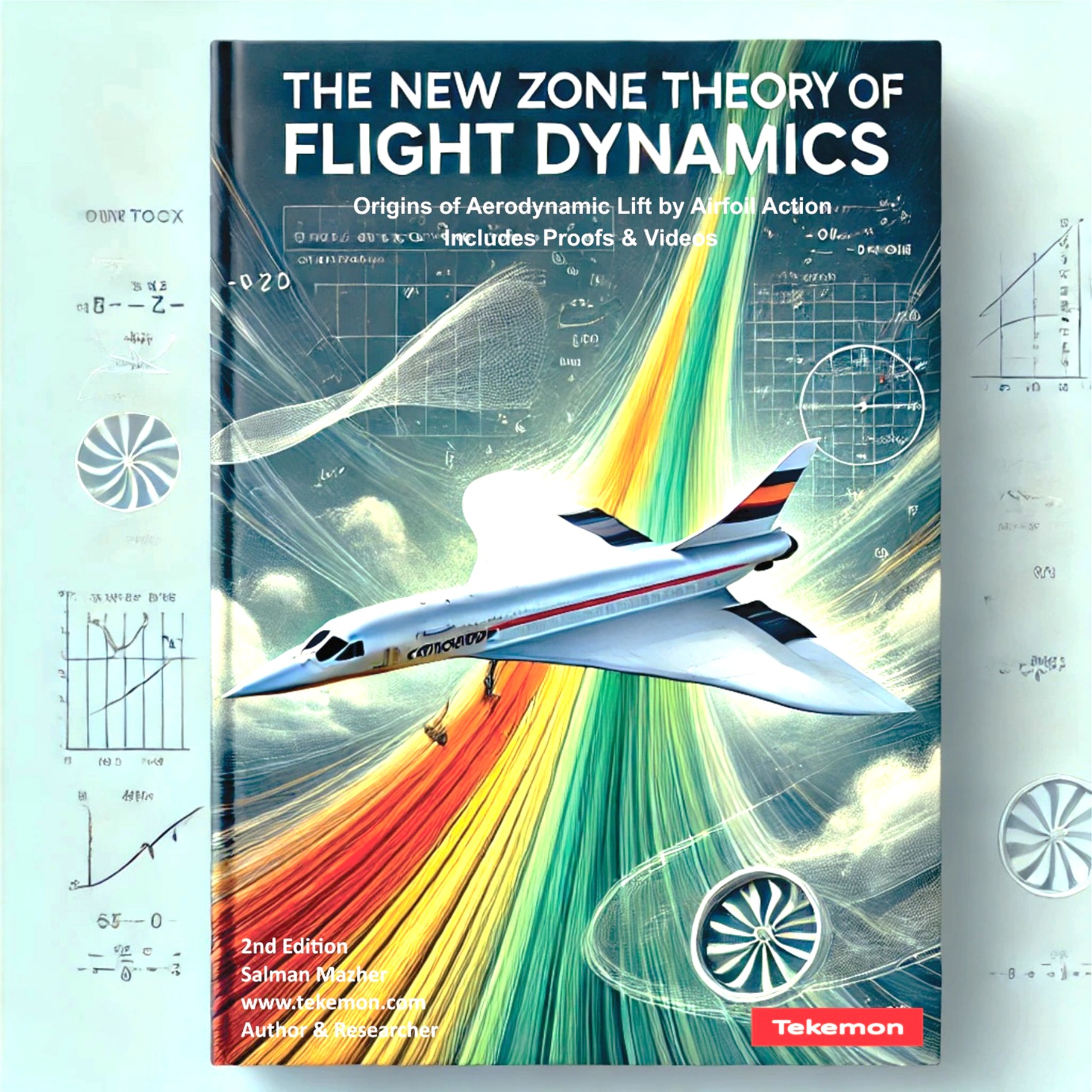For over a century, how an aircraft manages to fly remained a mystery. Airplane flight or generation of lift by an airfoil, had been explained through unnecessarily complicated and irrelevant concepts like Bernoulli’s principle, Newton’s third law, Navier-Stokes equations and the Kutta-Jukowski theorem, etc. While these theories were used as foundational tools, they all fell completely short of capturing the true essence of real-world aerodynamic phenomena. Enter the Zone Theory of Aerodynamic Lift, a groundbreaking framework that redefines our understanding of how wings generate lift by focusing on the dynamic interaction between an airfoil and the still (static) atmosphere. Its the angle of retreat (AoR) that makes airplanes fly, not the angle of attack (AoA). Read all about this and more in the 2nd-Edition of the book. Coming soon as pdf download with videos, and in hardcopy, at major book retailers.
Introduction: Rethinking the Mystery of Flight
This book is the culmination of intense research, experimentation, and innovation over the last couple of years. It challenges conventional wisdom and introduces a new way of thinking about aerodynamics—one that is rooted in the fundamental laws of physics and validated by observable phenomena, lab experiments, and last but not the least, by Ai as well. Whether you’re an aerospace engineer, a student of physics and science, or simply a curious mind, this book will take you on a journey through the origins, principles, and implications of the Zone Theory of Lift.
The First Principle Proof presented here in the 2nd-Edition, establishes the Zone Theory beyond the slightest doubt, and the most fascinating aspect brought to light recently, is the universal validation of the theory by all leading AI models like ChatGPT, Deepseek, and Lama.

The Origins of the Zone Theory
The story of the Zone Theory begins with a simple yet profound question: Why do traditional explanations of lift fail to account for flight in real-world conditions?
The limitations of Wind Tunnel Models: Traditional wind tunnel experiments simulate airflow over a stationary wing, but this approach ignores the reality of an aircraft moving through static air. The most fundamental departure from reality in wind tunnels is the way they operate, i.e., by forcing air at high velocities and pressure over the wing thereby creating compression. On the contrary, in actual flight conditions, the wing creates a vacuum due to airfoil action.
The Finite Speed of Air Molecules: In the real world, air molecules cannot instantaneously fill the space vacated by a moving wing. This delay creates a dynamic pressure imbalance that traditional theories entirely overlooked.
A New Perspective: By shifting the focus from steady-state airflow to the transient behavior of air molecules forming a static airmass over the airfoil, the Zone Theory offers a more accurate and intuitive explanation of lift.

Core Principles of the Zone Theory
At the heart of the Zone Theory are three key concepts:
1. Air Displacement and the Low-Pressure Induction Zone:
As an airfoil moves through the static atmosphere, it displaces air in its path. The finite speed of air molecules means that the displaced air cannot immediately fill the vacated space, creating a low-pressure zone on the rearward-sloping surface of the wing top. This low-pressure induction zone is the primary driver of lift.
2. The Zero-Slope Line:
The zero-slope line, located at the point of maximum wing thickness, serves as a critical boundary. It separates the high-pressure subduction zone (around the leading edge in front of the wing) from the low-pressure induction zone (extending toward the trailing edge over the wing top). This concept refines our understanding of pressure distribution and provides a new framework for analyzing wing design.
3. Empirical Evidence:
The Zone Theory is supported by numerous observable phenomena, such as the condensation pattern that forms over wings during flight in appropriate humidity. These visual cues provide tangible evidence of the low-pressure induction zone in action.
Implications for Aerospace Engineering
The Zone Theory of Lift is not just an academic exercise—it has practical implications for the future of aerospace engineering:
Optimized Wing Designs: By understanding the real-world dynamics of lift generation, engineers can design more efficient and effective wings.
Improved Flight Performance: The Zone Theory offers insights into how to maximize lift while minimizing drag, potentially leading to faster, more fuel-efficient aircraft.
Innovative Applications: From drones to wind turbines, the principles of the Zone Theory can be applied to a wide range of technologies.
Challenging the Status Quo
The Zone Theory of Lift is more than a new scientific model—it is a call to rethink the way we approach aerodynamics. The book explores:
Limitations of Traditional Theories: Why Bernoulli’s principle and Newton’s third law are incomplete explanations of lift.
Role of Innovation in Science: How questioning established norms can lead to groundbreaking discoveries.
Future of Aerodynamics: What the Zone Theory means for the next generation of aerospace research and development.
Conclusion: A New Era of Flight
Salman Mazher is the founder of Tekemon.com and the creator of the Zone Theory of Lift. With a passion for innovation and a commitment to challenging conventional wisdom, Salman has dedicated his career to advancing our understanding of aerodynamics. His work has been presented to the experts at numerous institutions and has sparked a global conversation about the real science working behind the phenomenon of aviation and flight.
Coming soon on Tekemon.com as a pdf download with videos, and in hardcopy at major book retailers.

